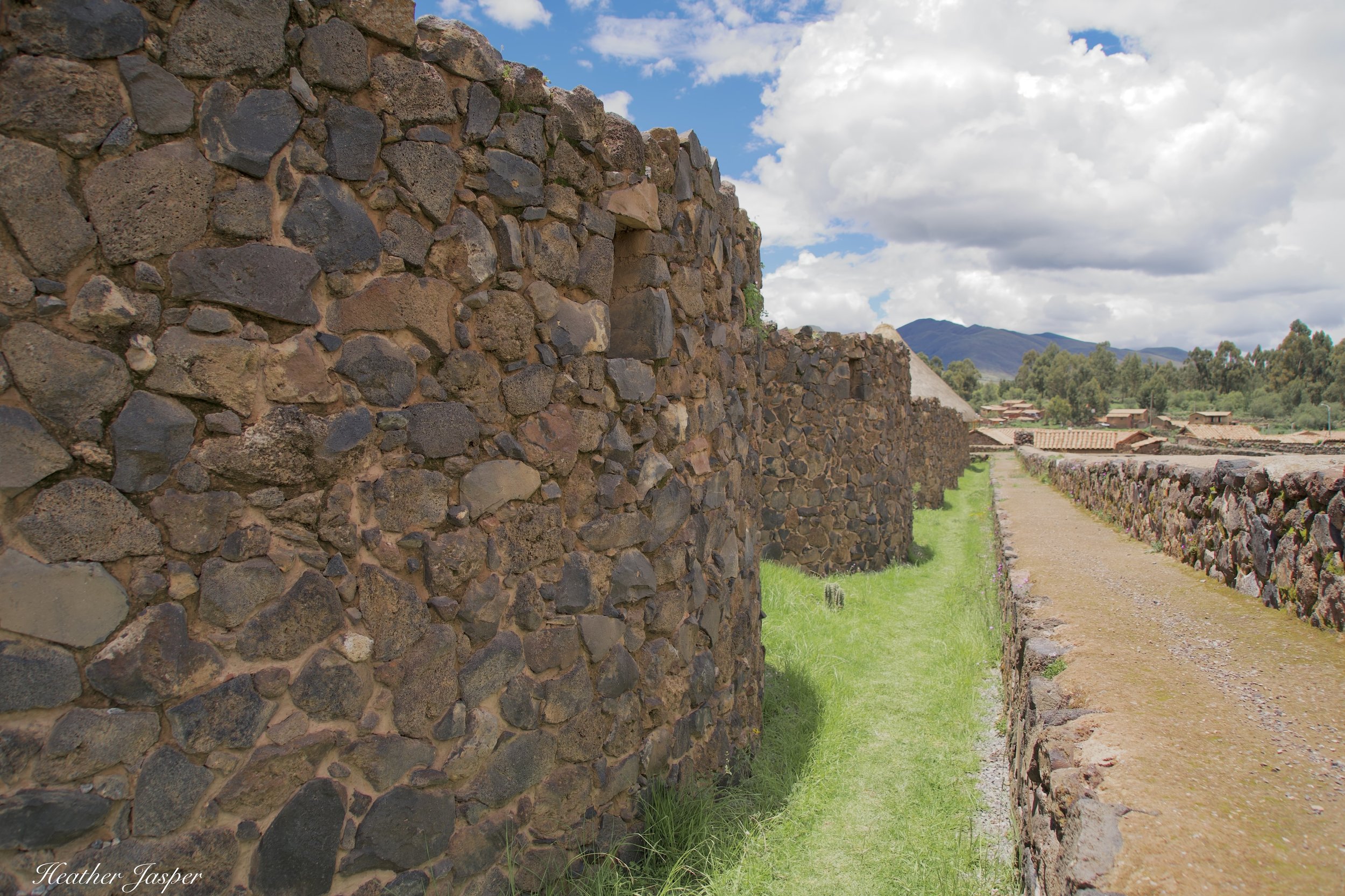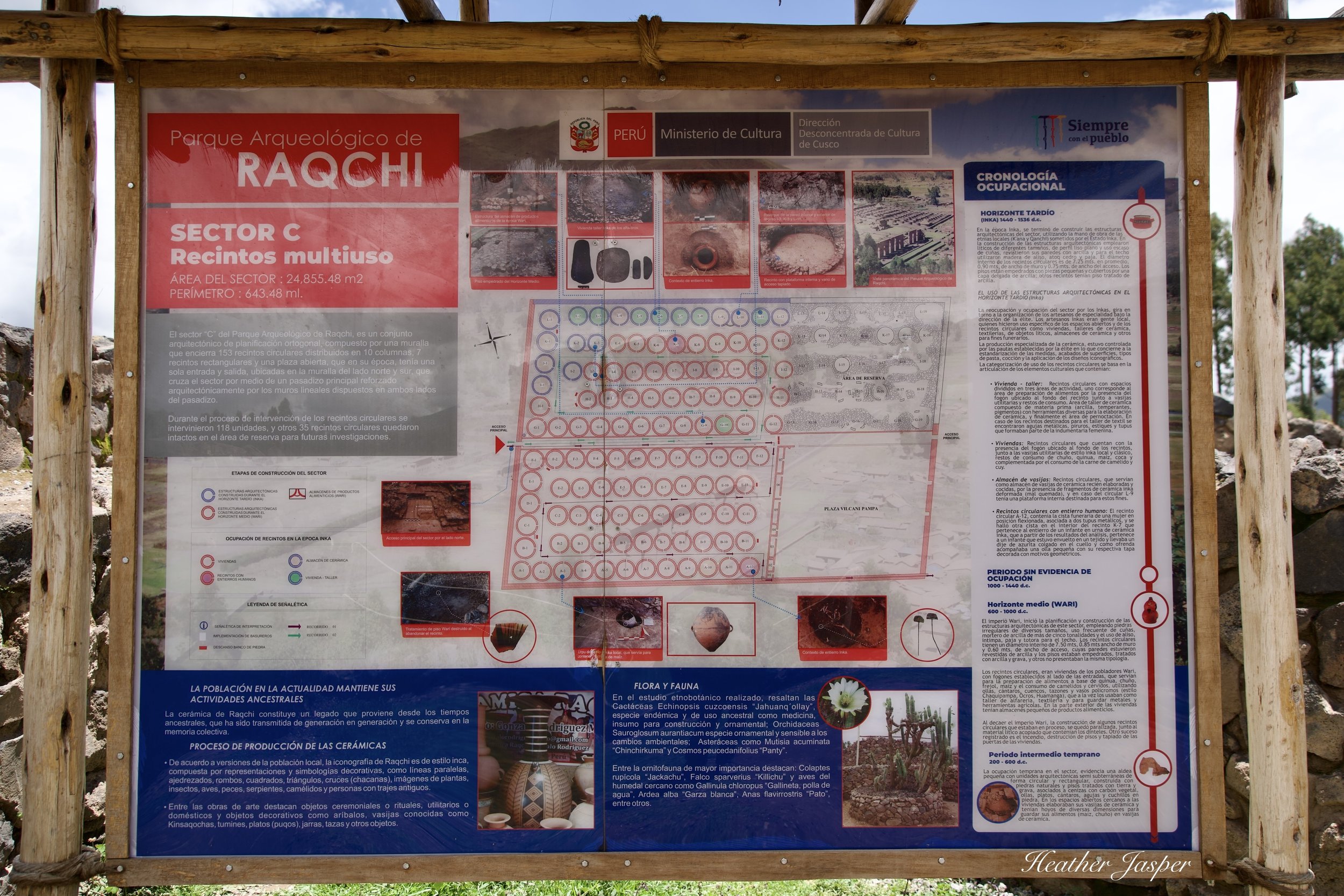Raqchi Ruins
Raqchi is the most unique Inca temple I’ve ever seen.
This central wall used to be inside the temple, the roof sloping down on the near and far sides.
Just two hours from Cusco are the ruins of an Inca temple unlike anything I’ve seen before. Since I started traveling around Peru in 2013, I’ve been to a lot of Inca ruins and a lot of Inca temples.
Raqchi is unique for several reasons.
1. It’s tall.
The wall that divided the temple in two, which held up the roofline, is still 40ft (12m) high. The Inca built out, not up. Their temples and cities are sprawling affairs. The highest walls I’d previously seen are at Sacsayhuaman. At the highest, those stone walls were probably 30ft (9m) high. The Spanish took the stones that they could for their own buildings, hence the estimation. Most temples are much lower. A 40ft high wall is a complete anomaly.
Partial restoration
On the left you can see new adobe was added to replaced collapsed sections and make the tall doorway and windows complete again.
2. It’s adobe.
The Inca are famous for building with stone. All their famous constructions are stone. There are a few examples of Inca adobe left at Pisac and Huchuy Q’oqso, but nothing like what’s at Raqchi. Before you want to call BS on adobe being more than 500 years old, the adobe at Raqchi is not just mud. It was made with a high concentration of llama fur, human hair, straw, and cactus juice. It’s most definitely more than 500 years old.
The Chakana
If you look carefully, you can see a zig-zag pattern of paint on the wall. (The white lines on the right are my drawing to help you see the paint). The painted stones formed the lower half of a chakana, the upper half was painted on the adobe.
The chakana is sometimes called the Andean Cross. Usually, the chakana looks like a pixelated diamond, with three layers above and three below. It represented the three levels of existence: the upper level was where the gods lived, symbolized by the condor; the middle level was where humans lived, represented by the puma; the lower level was for the dead, represented by the snake because it can shed its skin and be reborn.
The Raqchi chakanas had seven levels on the adobe and another seven painted on the stone. There is no universally accepted theory as to why the Raqchi chakanas don’t have three levels like all the others. One possibility is that they represented the seven colors of the rainbow, like Cusco’s flag.
Stone & adobe columns
The stone bases of the columns are oddly placed right where the doorways are built, so they partly block the entrances and exits.
3. It has columns.
The central wall held the center of the temple roof, but on each side, there were six columns. Like the center wall, they are stone below and adobe above. Round adobe columns. If you’ve ever seen that anywhere, please let me know because I don’t know any examples.
The Inca were very good with right angles and built very few circular things. There is a famous tower at Machu Picchu and the remains of towers at Sacsayhuamán, but very few examples of round constructions and none that I know of with columns.
A dozen columns
There are stone bases for six columns on each side of the wall, perhaps in classic Inca symbolism of the twelve moons of the year.
4. It’s on a flat valley floor.
The Inca built on high promontories, clifftops, and ridges over deep valleys. Their constructions are tall because of where they’re built, not because the walls they built are high. The Raqchi temple is near some hills that are the remnants of an extinct volcano, but it’s still very much a flat area.
A dozen houses
Next to the temple is a narrow passageway between a dozen tall buildings, six on each side just like the columns.
153 round houses
The straw roofs are long gone, but this is how close the houses are built to the wall that surrounds them.
5. It’s next to a city of circular buildings.
Right next to the temple was a trapezoidal walled compound with 153 round, one-room buildings, arranged in ten rows. Round buildings are not common in the Cusco area, though few of these were built by the Inca. It’s still an oddity for the region.
According to archeologists, 9 of the 10 rows were built by the pre-Inca Wari civilization and the tenth row was added by the Inca. Most of the ones built by the Wari were used for living quarters and the tenth row was mostly workshops and storage. Two of the houses that had been used for living quarters contained human burials, with the bodies inside ceramic urns.
Archeological discoveries
This sign from the Ministry of Culture describes what they found when excavating the 153 round structures.
The strangest thing about the rows of houses is that they are surrounded by a high wall. It’s a wall that looks built to keep people in, not out. Also, the houses are built touching each other, so you can’t walk between them. The only way to access the doors is at the end of the row. That means, there’s only one way in and no other way out.
The houses reminded me of the mita system, by which the Inca taxed the communities they conquered. Some communities paid their taxes in physical objects, like food or ceramics or cloth. Some paid it in days of labor. When they moved large groups from one place to another, they had to house and feed those workers. They weren’t prisoners, but they weren’t exactly free either.
The reason that there’s so must conjecture and guesswork about the Inca is because the Spanish were so thorough in their destruction of the culture. They kept their own notes and sent their own chroniclers to talk with the Inca, but everything that the Spanish recorded was seen through their lens. A lot was lost in translation and a lot was destroyed in the name of imposing Spanish language, religion, and culture.
Maybe I’ve read enough about the Inca by now that my theories have some logic. Maybe it’s just another foreigner’s opinion based on very little evidence. Maybe someday an archeologist will call me and tell me that they’ve found irrefutable evidence that these round buildings were used to house workers for the mita system.
Guided tours
I hired a guide named Alber at the door for s/30. Most people hire a guide from Cusco that provides transportation, but if you come on your own you can get a guide on the spot.
How to get there?
It took me two hours to drive to Raqchi. It’s about a third of the way to Lake Titicaca. If you don’t want to deal with your own transportation I suggest checking for tours on Viator.











